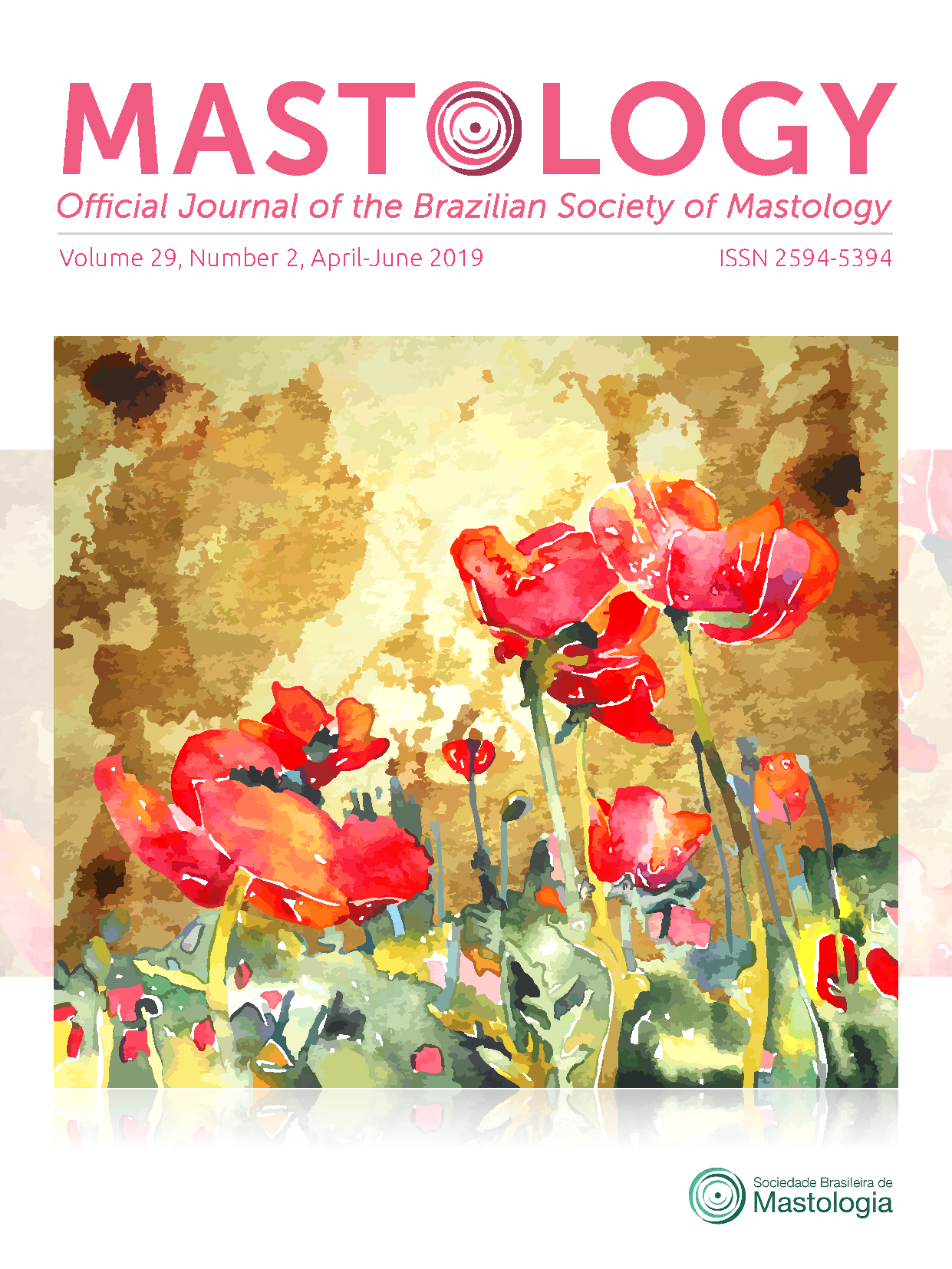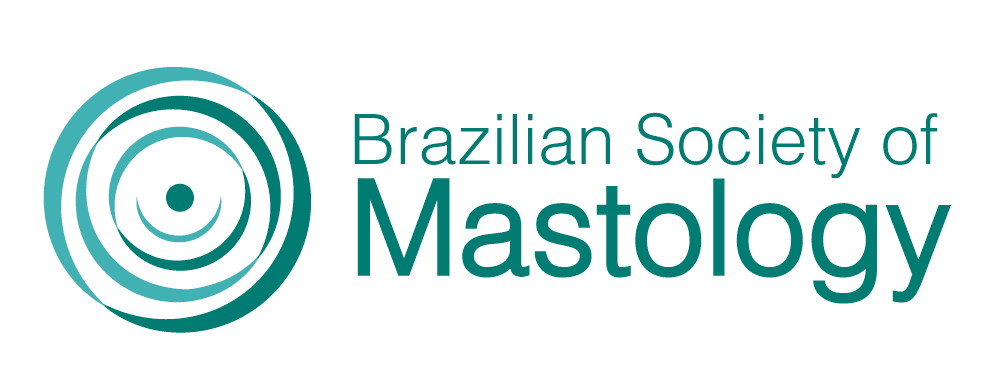Claudinas 1, 3, 4, 7 e sobrevida de 10 anos em tumores de mama triplo-negativos
Palavras-chave:
Neoplasias de mama, claudinas, análise de sobrevida, patologia, ginecologiaResumo
Objetivo: O câncer de mama é uma das principais causas de morbidade e mortalidade, conhecido por ser uma doença heterogênea. A caracterização clínica e molecular de seus subtipos é fundamental para orientar seu prognóstico e tratamento. O estudo da expressão de claudinas (CLDN) pode auxiliar na caracterização desses tumores. Este estudo investigou a associação da expressão de CLDN-1, CLDN-3, CLDN-4 e CLDN-7 com 10 anos de sobrevida em uma série de cânceres de mama triplo-negativos. Métodos: Oitenta tumores triplo-negativos foram analisados por imuno-histoquímica automatizada para CLDN-1, CLDN-3, CLDN-4 e CLDN-7. A expressão imuno-histoquímica foi avaliada pelo escore H (intensidade multiplicada pela porcentagem de coloração na membrana). As associações entre a expressão de CLDN e a sobrevida em 10 anos foram avaliadas pelas curvas de Kaplan-Meier e regressões de Cox. Resultados: Foi observada expressão positiva (escore H ≥ 50) de CLDN-1, CLDN-3, CLDN-4 e CLDN-7 em 41,3, 77,5, 67,5 e 18,8% da coorte, respectivamente. Pacientes com expressão positiva de CLDN-1 tiveram uma sobrevida significativamente menor do que suas contrapartes [HR = 2,37 (IC 95% 1,19-4,72)]. Além disso, o CLDN-3 foi inversamente associado à sobrevida global. Pacientes com expressão positiva de CLDN-1 e expressão negativa de CLDN-3 tiveram uma FC 10,4 (IC 95% 3,40–31,8) vezes maior do que pacientes com expressão negativa de CLDN-1 e expressão positiva de CLDN-3. Nem a expressão de CLDN-4 nem de CLDN-7 foi associada a uma sobrevida de 10 anos. Conclusões: A expressão diferencial de CLDN pode ajudar na caracterização clinico-patológica de tumores triplo-negativos. Além disso, CLDN-1 e CLDN-3 parecem ser importantes fatores prognósticos para esses tumores.
Downloads
Referências
Ferlay J, Shin HR, Bray F, Forman D, Mathers C, Parkin DM. Estimates of worldwide burden of cancer in 2008: GLOBOCAN 2008. Int J Cancer. 2010;127(12):2893-917. https://doi. org/10.1002/ijc.25516
Perou CM, Sorlie T, Eisen MB, van de Rijn M, Jeffrey SS, Rees CA, et al. Molecular portraits of human breast tumours. Nature. 2000;406(6797):747-52. https://doi.org/10.1038/35021093
Sorlie T, Perou CM, Tibshirani R, Aas T, Geisler S, Johnsen H, et al. Gene expression patterns of breast carcinomas distinguish tumor subclasses with clinical implications. Proc Natl Acad Sci USA. 2001;98(19):10869-74. https://doi.org/10.1073/ pnas.191367098
Stingl J, Caldas C. Molecular heterogeneity of breast carcinomas and the cancer stem cell hypothesis. Nat Rev Cancer. 2007;7(10):791-9. https://doi.org/10.1038/nrc2212
Dent R, Trudeau M, Pritchard KI, Hanna WM, Kahn HK, Sawka CA, et al. Triple-negative breast cancer: clinical features and patterns of recurrence. Clin Cancer Res. 2007;13(15 Pt 1):4429- 34. https://doi.org/10.1158/1078-0432.CCR-06-3045
Carey LA, Perou CM, Livasy CA, Dressler LG, Cowan D, Conway K, et al. Race, breast cancer subtypes, and survival in the Carolina Breast Cancer Study. JAMA. 2006;295(21):2492- 502. https://doi.org/10.1001/jama.295.21.2492
Sotiriou C, Neo SY, McShane LM, Korn EL, Long PM, Jazaeri A, et al. Breast cancer classification and prognosis based on gene expression profiles from a population-based study. Proc Natl Acad Sci USA. 2003;100(18):10393-8. https://doi.org/10.1073/ pnas.1732912100
Prat A, Perou CM. Deconstructing the molecular portraits of breast cancer. Mol Oncol. 2011;5(1):5-23. https://doi. org/10.1016/j.molonc.2010.11.003 9. Reddy KB. Triple-negative breast cancers: an updated review on treatment options. Curr Oncol. 2011;18(4):e173-9. REFERENCES
Haffty BG, Yang Q, Reiss M, Kearney T, Higgins SA, Weidhaas J, et al. Locoregional relapse and distant metastasis in conservatively managed triple negative early-stage breast cancer. J Clin Oncol. 2006;24(36):5652-7. https://doi. org/10.1200/JCO.2006.06.5664
Carey LA, Dees EC, Sawyer L, Gatti L, Moore DT, Collichio F, et al. The triple negative paradox: primary tumor chemosensitivity of breast cancer subtypes. Clin Cancer Res. 2007;13(8):2329-34. https://doi.org/10.1158/1078-0432.CCR-06-1109
Furuse M, Fujita K, Hiiragi T, Fujimoto K, Tsukita S. Claudin-1 and -2: novel integral membrane proteins localizing at tight junctions with no sequence similarity to occludin. J Cell Biol. 1998;141(7):1539-50.
Krause G, Winkler L, Mueller SL, Haseloff RF, Piontek J, Blasig IE. Structure and function of claudins. Biochimica Biophysica Acta. 2008;1778(3):631-45. https://doi.org/10.1016/j. bbamem.2007.10.018
Mineta K, Yamamoto Y, Yamazaki Y, Tanaka H, Tada Y, Saito K, et al. Predicted expansion of the claudin multigene family. FEBS Lett. 2011;585(4):606-12. https://doi.org/10.1016/j. febslet.2011.01.028
Ma F, Ding X, Fan Y, Ying J, Zheng S, Lu N, et al. A CLDN1- Negative Phenotype Predicts Poor Prognosis in Triple-Negative Breast Cancer. PLOS ONE. 2014;9(11):e112765. https://doi. org/10.1371/journal.pone.0112765
Kolokytha P, Yiannou P, Keramopoulos D, Kolokythas A, Nonni A, Patsouris E, et al. Claudin-3 and claudin-4: distinct prognostic significance in triple-negative and luminal breast cancer. Appl Immunohistochem Mol Morphol. 2014;22(2):125– 31. https://doi.org/10.1097/pai.0b013e31828d9d62
Bernardi MA, Logullo AF, Pasini FS, Nonogaki S, Blumke C, Soares FA, et al. Prognostic significance of CD24 and claudin-7 immunoexpression in ductal invasive breast cancer. Oncology Reports. 2012;27(1):28-38. https://doi.org/10.3892/or.2011.1477
Blanchard AA, Skliris GP, Watson PH, Murphy LC, Penner C, Tomes L, et al. Claudins 1, 3, and 4 protein expression in ER negative breast cancer correlates with markers of the basal phenotype. Virchows Arch. 2009;454(6):647-56. https://doi. org/10.1007/s00428-009-0770-6
Detre S, Saclani Jotti G, Dowsett M. A “quickscore” method for immunohistochemical semiquantitation: validation for oestrogen receptor in breast carcinomas. J Clin Pathol. 1995;48(9):876-8.
Rakha EA, Elsheikh SE, Aleskandarany MA, Habashi HO, Green AR, Powe DG, et al. Triple-negative breast cancer: distinguishing between basal and nonbasal subtypes. Clin Cancer Res. 2009;15(7):2302-10. https://doi.org/10.1158/1078- 0432.CCR-08-2132
Cheang MC, Voduc D, Bajdik C, Leung S, McKinney S, Chia SK, et al. Basal-like breast cancer defined by five biomarkers has superior prognostic value than triple-negative phenotype. Clin Cancer Res. 2008;14(5):1368-76. https://doi.org/10.1158/1078- 0432.CCR-07-1658
Perou CM. Molecular stratification of triple-negative breast cancers. Oncologist. 2011;16(Suppl. 1):61-70. https://doi. org/10.1634/theoncologist.2011-S1-61
Sorlie T, Tibshirani R, Parker J, Hastie T, Marron JS, Nobel A, et al. Repeated observation of breast tumor subtypes in independent gene expression data sets. Proc Natl Acad Sci USA. 2003;100(14):8418-23. https://doi.org/10.1073/pnas.0932692100
Chen LH, Kuo WH, Tsai MH, Chen PC, Hsiao CK, Chuang EY, et al. Identification of prognostic genes for recurrent risk prediction in triple negative breast cancer patients in Taiwan. PLoS One. 2011;6(11):e28222. https://dx.doi. org/10.1371%2Fjournal.pone.0028222
Gucalp A, Traina TA. Triple-Negative Breast Cancer: Adjuvant Therapeutic Options. Chemother Res Pract. 2011;2011:696208. https://doi.org/10.1155/2011/696208
Voduc KD, Cheang MC, Tyldesley S, Gelmon K, Nielsen TO, Kennecke H. Breast cancer subtypes and the risk of local and regional relapse. J Clin Oncol. 2010;28(10):1684-91. https://doi. org/10.1200/JCO.2009.24.9284
Morohashi S, Kusumi T, Sato F, Odagiri H, Chiba H, Yoshihara S, et al. Decreased expression of claudin-1 correlates with recurrence status in breast cancer. Int J Mol Med. 2007;20(2):139-43.
Szasz AM, Tokes AM, Micsinai M, Krenacs T, Jakab C, Lukacs L, et al. Prognostic significance of claudin expression changes in breast cancer with regional lymph node metastasis. Clin Exp Metastasis. 2011;28(1):55-63. https://doi.org/10.1007/s10585-010-9357-5
McClane BA, Hanna PC, Wnek AP. Clostridium perfringens enterotoxin. Microb Pathol. 1988;4(5):317-23.
Kominsky SL, Vali M, Korz D, Gabig TG, Weitzman SA, Argani P, et al. Clostridium perfringens enterotoxin elicits rapid and specific cytolysis of breast carcinoma cells mediated through tight junction proteins claudin 3 and 4. Am J Pathol. 2004;164(5):1627- 33. https://doi.org/10.1016/S0002-9440(10)63721-2
Downloads
Publicado
Como Citar
Edição
Seção
Licença
Copyright (c) 2019 Marcia Silveira Graudenz, Ermani Cadore, Bruna Pellini Ferreira, Renata Schulz, Clarissa Borba, Diego Uchoa, Mario Bernardes Wagner

Este trabalho está licenciado sob uma licença Creative Commons Attribution 4.0 International License.







